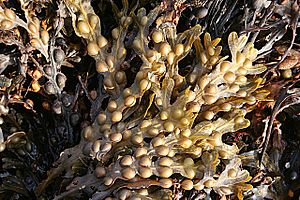Sarah Martha Baker facts for kids
Quick facts for kids
Sarah Martha Baker
|
|
|---|---|
| Born | 4 June 1887 |
| Died | May 1917 |
| Alma mater | University College London |
| Scientific career | |
| Fields | botany and ecology |
Sarah Martha Baker (1887–1917) was a brilliant English scientist. She studied plants (a botanist) and how living things interact with their environment (an ecologist). She is best known for her research on brown seaweeds and how different types grow in specific zones on the seashore.
Contents
Early Life and Interests
Sarah Martha Baker was born in London on June 4, 1887. She grew up in a Quaker family with her two younger brothers. Besides their London home, her family had a country house on Mersea Island. This is where Sarah first became interested in seaweed.
She loved plants and flowers from a very young age. Sarah also had a passion for art. She even studied briefly at the Slade School of Art. Her art training helped her create beautiful and accurate scientific drawings later on.
Education and Career Path
Sarah Baker began her studies at University College London in 1906. One of her teachers was the famous chemist Sir William Ramsay. In 1909, she earned her Bachelor of Science degree with top honors.
After a short time in Munich in 1910, she returned to London. There, she started doing research in botanical chemistry. People often described Sarah as very energetic and hardworking.
In 1912, she received the Quain Studentship in Botany. This important award also came with a teaching job at University College. This was a very modern place for its time. University College was the first school in the UK to accept female students. Also, its Botany Department was very open-minded. It gave many doctorates to women and hired female staff.
In 1913, Sarah earned her doctorate degree. Her research looked at how a chemical called formaldehyde affected living plants. In 1914, she became a fellow of the Linnean Society of London. This is a very old and respected science group. In 1916, she was chosen to join the Council of the British Ecological Society.
Important Research Discoveries

Sarah Baker was part of a new era in ecology. Scientists were starting to use experiments to learn more about nature. Sarah studied how different types of seaweed grow in specific zones on the seashore. She wanted to know if how much they could dry out (desiccation) decided where they lived.
She did a lot of hard work. She measured distances on the shore and collected many seaweed samples. She put them in jars and changed how much they were exposed to drying. Her findings suggested that different types of Fucaceae seaweeds competed with each other. This idea was not popular for a while, but now scientists agree it's part of the reason for seaweed zones. Some people even called her ideas "prophetic," meaning she saw the future of science.
Later, she studied how formaldehyde affected plants. Her experiments became even more detailed. She also studied photosynthesis, which is how plants make their own food. She planned to do more research in this area, but she passed away young.
Volunteering and Community Work
Besides her science work, Sarah also volunteered for the Society of Friends (Quakers). She is remembered for an inspiring quote. It came from her Sunday school students' memories of her. This quote is even on a special Quaker Tapestry panel about botanists.
When World War I started, she joined the University College's Voluntary Aid Detachment. This group helped with medical care during the war.
Later Life and Legacy
Sarah Martha Baker passed away on May 29, 1917. She was just about to turn 30 years old. The Times newspaper reported that her death was due to "overwork."
In 1919, the Sarah M. Baker Memorial Prize was created at University College London. This award is still given out today to honor her contributions to science.
Images for kids
See also
 In Spanish: Sarah Martha Baker para niños
In Spanish: Sarah Martha Baker para niños




